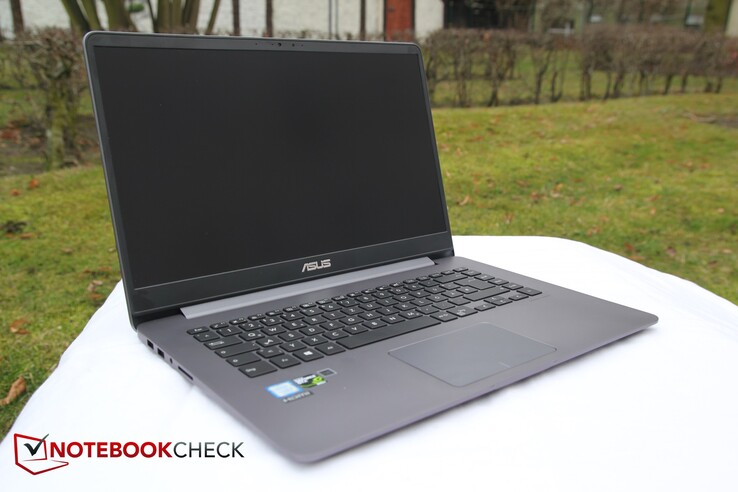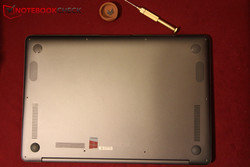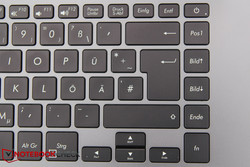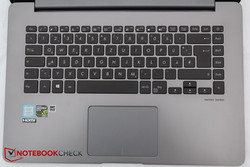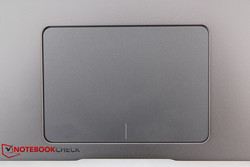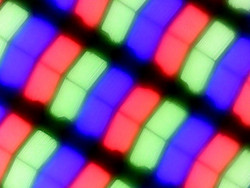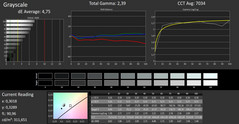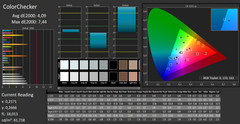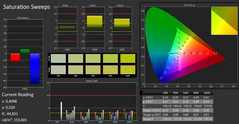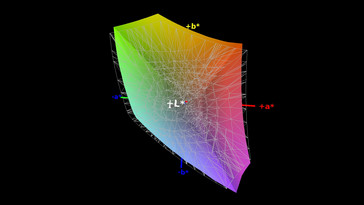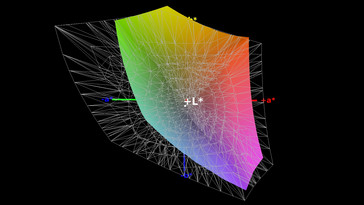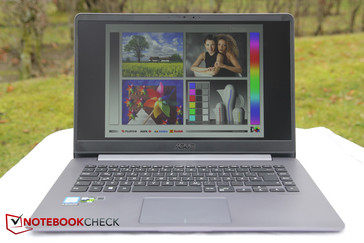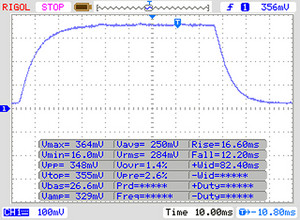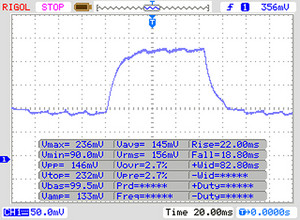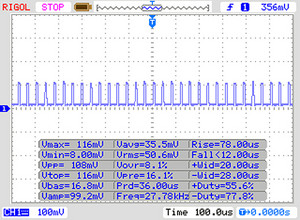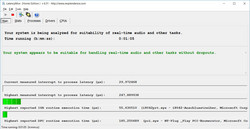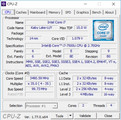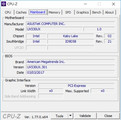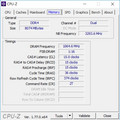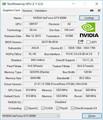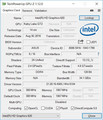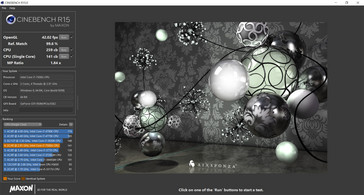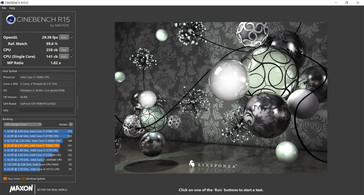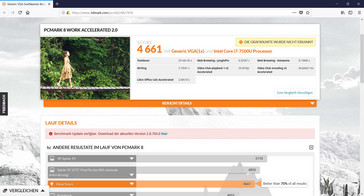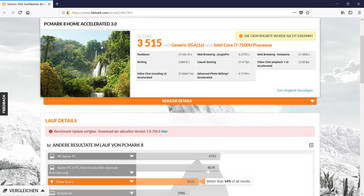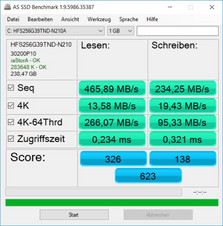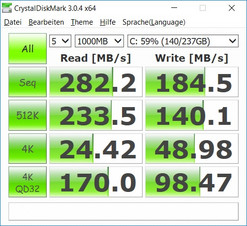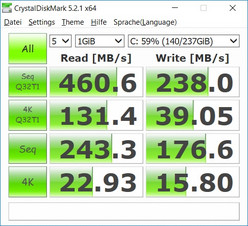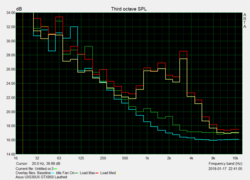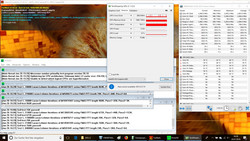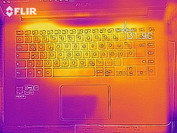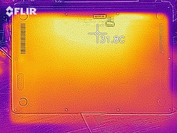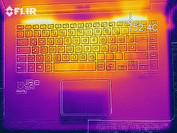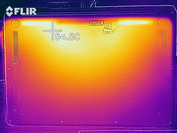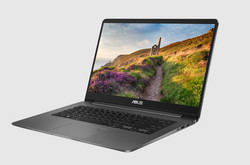Asus ZenBook UX530UX (i7-7500U, GTX 950M) Laptop Review

With the UX530UX, Asus has released a lightweight and compact 15-inch device with a new Kaby Lake processor and a slightly outdated GTX 950M. We are testing the variant FY070T, which is available for about 1200 Euros (~$1495). This is not exactly low-priced for a multimedia device with the aforementioned CPU/GPU combination as well as 8 GB of RAM and 256 GB of SSD storage. However, Asus delivers a device that still manages to stay very slim and lightweight despite the big screen, preserving its mobility.
Ultra-light 15-inch multimedia laptops are not exactly common. We will compare the new Asus device with the Lenovo ThinkPad E570 and the Acer Aspire E5-575G. This comparison is somewhat lacking because these models are considerably cheaper at a price range of 600 to 700 Euros (~$747 to ~$872), but they are also less mobile at a weight of 2.5 kg. Furthermore, they are equipped with "only" the Core i5 (Kaby Lake as well). Additionally, we used the more expensive Asus ZenBook Pro UX550VD as reference for comparison, which is equipped with a more recent GTX 1050, 16 GB of RAM and a processor that is clocked at a slightly higher speed.
Case
Despite its low weight, the new ZenBook's silver-gray case is made mostly of aluminum. The upper side has a smooth, slightly glossy finish, while the bottom and the inner surfaces are slightly roughened. Only the screen's inner frame is made of black plastic. The sparing use of plastic provides this laptop with a very stable base. The thin lid is naturally less torsion-resistant, but at least the display does not show any discolorations in reaction to our flexural tests.
The design is simple yet elegant. Our test device comes in the color option "Quartz Gray". Alternatively, it is available in the variant "Royal Blue". Because of the light weight, both hands are needed to open the lid. To facilitate opening the lid, there is a small notch in the front middle of the base unit. The keyboard is orderly and neatly arranged. The display is framed by bezels which are pleasantly narrow, especially at the sides. The build quality seems to be high in general, since we did not notice any troubling gaps or creaking noises.
The ventilation slits have been placed to the bottom left and right and, barely visible, beneath the hinges at the back. Sadly, the UX530UX does not offer a maintenance hatch or an exchangeable battery. Furthermore, hexalobular screws complicate the maintenance.
The size and weight comparison is slightly unfair because the Acer and Lenovo devices were not designed as Ultrabooks. In general, there are not many representatives of this type of notebook in a 15-inch format, so the ZenBook is almost unrivaled and can easily beat its rivals in regard to measurements and weight. The rivals are 8 to 12 mm thicker and 19 to 22 mm longer. While the UX530 weighs only about 1.63 kg, the two comparison devices have weights of 2.3 and 2.4 kg.
However, the sister model is barely larger and thicker and weighs only 300 grams more, but it is also equipped with better hardware. Still, it should be noted that the UX530 is an especially light and compact 15-inch device.
Connectivity
Concerning the connectivity, the ZenBook is somewhat stingy. Two USB 2.0 ports are not necessary nowadays and should have been replaced by USB 3 ports. Furthermore, you will not find an RJ45 port, so LAN cables cannot be plugged in because the UX530 uses WLAN exclusively. The USB Type-C port sadly belongs to the first generation, so Thunderbolt is not supported. At least DisplayPort is supported and a separate HDMI port is present. Headphones and microphone have to share a single audio port.
Considering the low number of ports, the positioning should have been more widespread, but the distance between the ports is relatively small. All the ports are crowded into the left and right rear areas. Two USB sticks of the wider kind could impede each other and a thicker HDMI cable could come into conflict with a USB device.
SD Card Reader
The card reader test reveals that Asus apparently cut costs with the card reader model. Using our reference card Toshiba Exceria Pro SDXC 64 GB UHS-II, we determined that even the Lenovo and Acer notebooks which cost half the price are equipped with card readers twice or three times as fast. The ZenBook Pro has a considerably faster variant as well.
| SD Card Reader | |
| average JPG Copy Test (av. of 3 runs) | |
| Asus ZenBook Pro UX550VD (Toshiba Exceria Pro M501) | |
| Lenovo ThinkPad E570-20H6S00000 (Toshiba Exceria Pro SDXC 64 GB UHS-II) | |
| Acer Aspire E5-575G-549D (Toshiba Exceria Pro SDXC 64 GB UHS-II) | |
| Asus ZenBook UX530UX-FY070T (Toshiba Exceria Pro SDXC 64 GB UHS-II) | |
| maximum AS SSD Seq Read Test (1GB) | |
| Lenovo ThinkPad E570-20H6S00000 (Toshiba Exceria Pro SDXC 64 GB UHS-II) | |
| Acer Aspire E5-575G-549D (Toshiba Exceria Pro SDXC 64 GB UHS-II) | |
| Asus ZenBook UX530UX-FY070T (Toshiba Exceria Pro SDXC 64 GB UHS-II) | |
Communication
However, the ZenBook UX530UX fares far better in regard to the communication modules. It outpaces even the ZenBook Pro, taking the lead in transmission power, even though the ZenBook Pro beats the UX530UX in reception by a narrow margin.
Concerning the "HD" webcam, it is incomprehensible for us why any cheap smartphone still has better cameras than a laptop in the age of Skype, Twitch, YouTube & co. This laptop's images are no exception, lacking detail and being so noisy that one cannot help but wonder how video telephony and video-streaming could ever become popular under these circumstances. The following sample image conveys said impression.
| Networking | |
| iperf3 transmit AX12 | |
| Asus ZenBook UX530UX-FY070T | |
| Lenovo ThinkPad E570-20H6S00000 | |
| Asus ZenBook Pro UX550VD | |
| iperf3 receive AX12 | |
| Asus ZenBook Pro UX550VD | |
| Asus ZenBook UX530UX-FY070T | |
| Lenovo ThinkPad E570-20H6S00000 | |
Security
The device is promoted on Asus' website as having a fingerprint sensor in the upper-right corner of the glass touchpad. Our test device was not equipped with this fingerprint sensor which is available only optionally. So this is something to pay attention to when purchasing if you are interested in this kind of functionality.
Accessories
Other than the device itself and the power supply, the box contained only a quick-start guide and a warranty booklet.
Maintenance
The battery cannot be removed and the UX530UX sadly does not have a maintenance hatch. The base plate is held by 10 small screws. To unscrew these, you need a Torx screwdriver. If you do not own a screwdriver of the required size, you are out of luck, which makes opening the case unnecessarily complicated. We used the smallest hexalobular driver from our precision toolkit and even that was still too wide and only just worked. After loosening the screws, the base plate barely reacted to pressure on the usual weak points.
We abandoned our attempt of opening the case for fear of bending the aluminum or worse. It is possible there are even more hidden screws beneath the rubber feet. The maintenance is unnecessarily complicated, especially for inexperienced users. Our colleague had fewer problems with opening the ZenBook Pro.
Warranty
The manufacturer offers a two-year collect & return warranty for the laptop. The warranty period can be prolonged for a surcharge in various shops.
Please see our Guarantees, Return Policies and Warranties FAQ for country-specific information.
Input Devices
Keyboard
The chiclet keyboard appears orderly and has a well-spaced layout. Merely the compacted arrow keys were troublesome and it took some time to get used to the key bar on the right-hand edge of the keyboard. This bar includes the power key at the top, beneath that the "Home" key, the "Page Up"/"Page Down" keys and the "End" key as well as the "fn" key at the very bottom. The key travel is very short and the actuation borders on being too hard. The typing noise is definitely acceptable.
The keyboard makes a good impression while typing on it, since nothing wobbles or rattles. Thanks to the stable base, the keyboard does not yield while typing on it; that would require more pressure from above. The placement of the power key at the upper-right corner of the keyboard is worse than a separate button because accidental activation of the laptop's sleep mode is not too uncommon an experience under these circumstances. Users of this device may miss having a numeric keypad, which might have been nice to integrate into a 15-inch device. The keyboard can be illuminated in three brightness levels.
Touchpad
According to Asus, the touchpad has a glass surface. Indeed, the surface is very smooth to the touch and fingers glide easily on it. Gestures with up to four fingers are supported. Optionally, there are also models with an integrated fingerprint sensor in the upper-right corner. With an area of 73x104 mm, the pad offers enough space for all gestures and for precise navigation. There are no separate mouse buttons; instead, the lower part of the pad can be pushed down. The clicking noises are much too loud for our taste, which gives the pad a lower-quality impression, even though it is otherwise convincing.
Display
The installed display is a Full HD IPS panel by Chi Mei. The most prominent feature is the very narrow side bezels of the matte NanoEdge screen. This results in a screen-to-body ratio of 81%. The panel supposedly supports 100% sRGB. Furthermore, an ambient light sensor is included which adjusts the screen's brightness automatically. This feature can be activated or deactivated by pressing a special key on the keyboard. There is no screen-bleeding visible to the naked eye. When looking really closely in a dark environment, yellowish halos can be seen in the lower corners.
The display achieved very good results during our measurements. Only the ZenBook Pro could barely surpass the UX530UX's average brightness of 296 cd/m². However, the brightness could be more evenly distributed; 80% is an only just acceptable result. The Acer is clearly superior with a brightness distribution of 90%, while the Lenovo is rather bad at 75%.
| |||||||||||||||||||||||||
Brightness Distribution: 80 %
Contrast: 1288:1 (Black: 0.24 cd/m²)
ΔE ColorChecker Calman: 4.09 | ∀{0.5-29.43 Ø4.79}
ΔE Greyscale Calman: 4.75 | ∀{0.09-98 Ø5}
90% sRGB (Argyll 1.6.3 3D)
58% AdobeRGB 1998 (Argyll 1.6.3 3D)
65.2% AdobeRGB 1998 (Argyll 3D)
90.6% sRGB (Argyll 3D)
64.3% Display P3 (Argyll 3D)
Gamma: 2.39
CCT: 7034 K
| Asus ZenBook UX530UX-FY070T Chi Mei CMN15E8, , 1920x1080, 15.6" | Lenovo ThinkPad E570-20H6S00000 AUO B156HAN04.4, , 1920x1080, 15.6" | Acer Aspire E5-575G-549D Chi Mei CMN15C4, , 1920x1080, 15.6" | Asus ZenBook Pro UX550VD CMN15E8 (N156HCE-EN1), , 1920x1080, 15.6" | |
|---|---|---|---|---|
| Display | -38% | -39% | 1% | |
| Display P3 Coverage (%) | 64.3 | 38.65 -40% | 38.57 -40% | 65.7 2% |
| sRGB Coverage (%) | 90.6 | 58 -36% | 57.4 -37% | 90.3 0% |
| AdobeRGB 1998 Coverage (%) | 65.2 | 39.94 -39% | 39.89 -39% | 65.9 1% |
| Response Times | -2% | 8% | 3% | |
| Response Time Grey 50% / Grey 80% * (ms) | 40 ? | 44.8 ? -12% | 39 ? 2% | 38.8 ? 3% |
| Response Time Black / White * (ms) | 28 ? | 25.6 ? 9% | 24 ? 14% | 27.2 ? 3% |
| PWM Frequency (Hz) | 25000 ? | 25910 ? | ||
| Screen | -16% | -61% | -4% | |
| Brightness middle (cd/m²) | 309 | 242 -22% | 176 -43% | 335 8% |
| Brightness (cd/m²) | 296 | 243 -18% | 169 -43% | 313 6% |
| Brightness Distribution (%) | 80 | 75 -6% | 91 14% | 83 4% |
| Black Level * (cd/m²) | 0.24 | 0.24 -0% | 0.47 -96% | 0.27 -13% |
| Contrast (:1) | 1288 | 1008 -22% | 374 -71% | 1241 -4% |
| Colorchecker dE 2000 * | 4.09 | 4.65 -14% | 8.83 -116% | 4.7 -15% |
| Colorchecker dE 2000 max. * | 7.44 | 9.64 -30% | 14.01 -88% | 8.1 -9% |
| Greyscale dE 2000 * | 4.75 | 3.39 29% | 8.97 -89% | 5.8 -22% |
| Gamma | 2.39 92% | 2.7 81% | 2.43 91% | 2.06 107% |
| CCT | 7034 92% | 6246 104% | 10234 64% | 6518 100% |
| Color Space (Percent of AdobeRGB 1998) (%) | 58 | 36.69 -37% | 36.8 -37% | 58.7 1% |
| Color Space (Percent of sRGB) (%) | 90 | 57.66 -36% | 57.3 -36% | 90.1 0% |
| Total Average (Program / Settings) | -19% /
-18% | -31% /
-47% | 0% /
-2% |
* ... smaller is better
The ZenBook UX530UX takes the lead again for black level (0.24) and contrast (1288:1), outdoing even the ZenBook Pro. The color representation and grayscale measurements show good results as well which do not leave much to be desired. Instead of the promised 100% sRGB color-space coverage, our measurement equipment determined "only" 90%. 58% of the AdobeRGB color space is covered. With these results, the less expensive rivals are left behind; the ZenBook Pro is up to par.
Noteworthy: The display utilizes PWM as a means of brightness control at a value of 20% and below. However, the high frequency of 20,000 Hz should not cause any problems even for sensitive users.
As an especially lightweight 15-inch laptop, the UX530UX has to meet high expectations for mobile use, which should also be reflected in its outdoor usability. Our own experiences confirm that this laptop can satisfy these expectations. The brightness is usually sufficient for outdoor usage. The good black level and the high contrast as well as the anti-glare display contribute to the readability of the screen content outdoors.
Display Response Times
| ↔ Response Time Black to White | ||
|---|---|---|
| 28 ms ... rise ↗ and fall ↘ combined | ↗ 16 ms rise | |
| ↘ 12 ms fall | ||
| The screen shows relatively slow response rates in our tests and may be too slow for gamers. In comparison, all tested devices range from 0.1 (minimum) to 240 (maximum) ms. » 70 % of all devices are better. This means that the measured response time is worse than the average of all tested devices (20.3 ms). | ||
| ↔ Response Time 50% Grey to 80% Grey | ||
| 40 ms ... rise ↗ and fall ↘ combined | ↗ 22 ms rise | |
| ↘ 18 ms fall | ||
| The screen shows slow response rates in our tests and will be unsatisfactory for gamers. In comparison, all tested devices range from 0.165 (minimum) to 636 (maximum) ms. » 60 % of all devices are better. This means that the measured response time is worse than the average of all tested devices (31.7 ms). | ||
Screen Flickering / PWM (Pulse-Width Modulation)
| Screen flickering / PWM detected | 25000 Hz | ≤ 20 % brightness setting | |
The display backlight flickers at 25000 Hz (worst case, e.g., utilizing PWM) Flickering detected at a brightness setting of 20 % and below. There should be no flickering or PWM above this brightness setting. The frequency of 25000 Hz is quite high, so most users sensitive to PWM should not notice any flickering. In comparison: 53 % of all tested devices do not use PWM to dim the display. If PWM was detected, an average of 8167 (minimum: 5 - maximum: 343500) Hz was measured. | |||
Performance
With its up-to-date Kaby Lake processor, a dedicated graphics card, 8 GB of RAM, and SSD mass storage, the ZenBook UX530UX is a real allrounder and a multimedia talent in regard to its performance. None of the components are absolutely high-end, but the chosen constellation of components combines sufficient performance with economy and mobility. So this device primarily makes sense for users who appreciate a nice, big screen, but who still want mobility and the ability to process almost any arising task. Thanks to the dedicated graphics card, even video-editing and the occasional gaming experience with less-demanding titles are possible. A smooth usage of office and Internet applications is taken for granted with these components.
Processor
Asus chose the particularly energy-efficient Intel Core i7-7200U as the processor for the ZenBook UX530UX. The "U" in this type designation signifies the CPU's energy efficiency, but this is still one of the most powerful dual-core CPUs of the Kaby Lake generation with clock rates between 2.7 and 3.5 GHz. Thanks to Hyper-Threading, the processor has the ability to virtually duplicate cores, enabling it to process up to four threads simultaneously. Furthermore, the CPU includes an integrated graphics unit, the Intel HD Graphics 620, causing the dedicated graphics card to be shut down in normal Windows routine and prolonging the battery runtime this way.
In the 30-minute loop by Cinebench R15, the multi-core clock speed settled at about 3 GHz. The maximum clock speed of 3.5 GHz was never reached, but the base clock of 2.7 GHz was never undercut either, so this cannot be called throttling. However, there was a single outlier, so the device does not always reliably deliver its standard performance either.
If the device is disconnected from the power outlet, the clock speed drops noticeably. The clock speed fluctuated between 400 MHz (!) and 3 GHz in the multi-core test. However, this affected only the OpenGL score. Clock speed fluctuated less in the single- and multi-core tests and the result was comparable to the values while plugged in.
The direct comparison with the competitors is slightly surprising. Even though the Lenovo and the Acer are equipped with weaker processors, they are clearly ahead of the ZenBook UX530 in the Cinebench multi-core test, of all things. Their CPUs have access to the virtual core duplication as well, but they should still be at a disadvantage in general. The impact of the clock speed shows clearly here. While the Lenovo and the Acer are able to keep their maximum Turbo speed even during the multi-core test, the clock speed of the UX530 drops to a maximum of 3 GHz, so that the device falls back behind its rivals by 7 to 8%. The device disappoints with its unused potential.
However, the ZenBook UX530UX did not suffer from this problem in the single-core test. It can keep its maximum Turbo speed of about 3.5 GHz stable, being faster than the rivals with a lower clock speed. The ZenBook Pro with its Core i7-7700HQ is faster by another 15%.
System Performance
Regarding the system performance, the UX530 is on a par with the Lenovo. The PCMark 8 "Work" and "Home" scores show almost equal results for both devices, while the Acer has a deficit of about 10 to 13%. Normally, the UX530 should have an even better score because of its more powerful CPU. On the other hand, the performance also relies on other factors such as the installed mass storage, which we will take a look at below. However, the CPU seems to be unable to reach its full potential another time in this test. The ZenBook Pro is ahead by about 8 to 20%.
| PCMark 8 Home Score Accelerated v2 | 3515 points | |
| PCMark 8 Work Score Accelerated v2 | 4661 points | |
Help | ||
Mass Storage
The storage is another reason for the mediocre system performance: Asus unfortunately installed only a mediocre SSD with 256 GB of storage. The ZenBook Pro and also the Lenovo use clearly better SSDs, only the Acer's HDD has naturally even worse results. It is shameful for a device in this price range to be beaten by the Lenovo that costs only half as much. The SK Hynix used in the ZenBook UX530 ranked only 201st in our SSD/HDD leaderboard while the Toshiba SSD installed in the Lenovo ranked 68th.
| Asus ZenBook UX530UX-FY070T SK Hynix HFS256G39TND-N210A | Lenovo ThinkPad E570-20H6S00000 Toshiba THNSF5256GPUK | Acer Aspire E5-575G-549D Toshiba MQ01ABD100 | Asus ZenBook Pro UX550VD Samsung PM961 NVMe MZVLW512HMJP | |
|---|---|---|---|---|
| CrystalDiskMark 3.0 | 188% | -86% | 334% | |
| Read Seq (MB/s) | 282.2 | 1140 304% | 95.3 -66% | 1434 408% |
| Write Seq (MB/s) | 184.5 | 468.1 154% | 85.6 -54% | 1365 640% |
| Read 512 (MB/s) | 233.5 | 759 225% | 29.32 -87% | 614 163% |
| Write 512 (MB/s) | 140.1 | 414 196% | 25.93 -81% | 688 391% |
| Read 4k (MB/s) | 24.42 | 34.3 40% | 0.366 -99% | 60.6 148% |
| Write 4k (MB/s) | 48.98 | 123.4 152% | 0.726 -99% | 158 223% |
| Read 4k QD32 (MB/s) | 170 | 530 212% | 0.647 -100% | 617 263% |
| Write 4k QD32 (MB/s) | 98.5 | 319.2 224% | 0.722 -99% | 525 433% |
Graphics Card
The graphics card installed by Asus is an Nvidia GTX 950M. The DirectX 11 card stems from the previous generation of Nvidia graphics accelerators and cannot keep up with the latest 10 series. It has 2 GB of RAM and does not support HDMI 2.0 yet. Fortunately, this is the slightly faster version with GDDR5 RAM, which promises a potentially 10 to 20% better performance than the slower GDDR3 variant. However, it appears that this card has been slightly throttled from the start. Instead of the usual clock rate of 1,250 MHz, the installed model has a clock rate of only 1,066 MHz. Still, it should be sufficient for most tasks, but the details and resolution have to be reduced significantly in current games to still allow for a fluent gaming experience.
Even though all of the devices, with the exception of the ZenBook Pro, utilize the same graphics card, the UX530UX occupies the last spot in each of our 3DMark tests. The 3% difference for 3DMark 11 is within the measurement uncertainty range, which is the reason why all three devices rank equally here. The differences in the 3DMark 2013 are larger, however, and they are much more troublesome for the ZenBook UX530: Our test device fell behind its rivals by 8% during the "Fire Strike" test and by 15 to 18% during the "Cloud Gate" test. Considering the hardware, this result is hardly acceptable and illustrates that the graphics performance is throttled by the reduced clock rates.
If the device is disconnected from the grid, the performance is throttled extremely. The result of the "Cloud Gate" test dropped from an earlier value of 18,961 to only 6,900, which is a decrease by almost 64%! The average frame rate while playing The Witcher 3 dropped from 46 fps to barely 30 fps. This makes it difficult to run any graphically demanding applications such as games or video-editing software when unplugged from the wall socket.
| 3DMark 11 - 1280x720 Performance GPU | |
| Asus ZenBook Pro UX550VD | |
| Average NVIDIA GeForce GTX 950M (4046 - 4678, n=28) | |
| Acer Aspire E5-575G-549D | |
| Lenovo ThinkPad E570-20H6S00000 | |
| Asus ZenBook UX530UX-FY070T | |
| 3DMark | |
| 1280x720 Cloud Gate Standard Graphics | |
| Asus ZenBook Pro UX550VD | |
| Acer Aspire E5-575G-549D | |
| Lenovo ThinkPad E570-20H6S00000 | |
| Average NVIDIA GeForce GTX 950M (18547 - 25900, n=28) | |
| Asus ZenBook UX530UX-FY070T | |
| 1920x1080 Fire Strike Graphics | |
| Asus ZenBook Pro UX550VD | |
| Acer Aspire E5-575G-549D | |
| Lenovo ThinkPad E570-20H6S00000 | |
| Asus ZenBook UX530UX-FY070T | |
| Average NVIDIA GeForce GTX 950M (2931 - 3638, n=28) | |
| 3DMark 11 Performance | 4006 points | |
| 3DMark Cloud Gate Standard Score | 1262 points | |
| 3DMark Fire Strike Score | 2638 points | |
Help | ||
| low | med. | high | ultra | |
|---|---|---|---|---|
| The Witcher 3 (2015) | 42.5 | 36.04 | 20.02 | 10.71 |
| Rise of the Tomb Raider (2016) | 67.1 | 37.32 | 21.49 | 17.89 |
| Rocket League (2017) | 143.2 | 54.8 | 40.33 |
Gaming Performance
The Witcher 3 can be played fluently only on medium or lower settings. At a resolution of 1366x768 and on medium details, the ZenBook UX530 manages an average frame rate of 36 fps. This leaves barely any headroom for potentially more demanding scenes. On lowest settings (1024x768, low), the UX530 at least manages 46 fps. Away from the grid, this value drops to 30 fps in battery mode and so falls below the threshold of fluent playability.
The less-demanding Rocket League can be played fluently in Full HD on high details. Our test device runs at an average of 40 fps here.
Rise of the Tomb Raider is more demanding again. A fluent gaming experience is possible at a resolution of 1366x768 on medium details at an average of 37 fps. The device can even reach 60 fps on minimum settings (1024x768, low).
The synthetic graphics tests already let us assume what the games proved: The ZenBook UX530 does not manage to outpace its two rivals which cost only half as much. The Lenovo is actually faster in several cases. We only have comparative values of the rivals for Rise of the Tomb Raider. In Full HD on high details, the Asus ZenBook is on a par with the Lenovo. On low settings, it actually falls behind by about 7 to 8%. Only the Acer fares worse. The measured values mostly match the scores for our reference model, the GTX 950M from our benchmark list.
In summary it can be said that the GTX 950M in the ZenBook offers enough performance for less-demanding games such as Rocket League, even in Full HD. This is the exception, however, since the resolution and details have to be reduced drastically for more current titles. Full HD is usually not an option any longer in this case. Many titles can at least still be played at 1366x768 on medium details, but especially demanding scenes or games might require a further reduction.
| The Witcher 3 | |
| 1024x768 Low Graphics & Postprocessing | |
| Average NVIDIA GeForce GTX 950M (42.5 - 67, n=7) | |
| Asus ZenBook UX530UX-FY070T | |
| 1366x768 Medium Graphics & Postprocessing | |
| Asus ZenBook Pro UX550VD | |
| Average NVIDIA GeForce GTX 950M (33 - 40.7, n=8) | |
| Asus ZenBook UX530UX-FY070T | |
| 1920x1080 High Graphics & Postprocessing (Nvidia HairWorks Off) | |
| Asus ZenBook Pro UX550VD | |
| Asus ZenBook UX530UX-FY070T | |
| Average NVIDIA GeForce GTX 950M (16.2 - 22.3, n=7) | |
| Rocket League | |
| 1280x720 Performance | |
| Asus ZenBook UX530UX-FY070T | |
| Average NVIDIA GeForce GTX 950M (n=1) | |
| 1920x1080 Quality AA:Medium FX | |
| Asus ZenBook UX530UX-FY070T | |
| Average NVIDIA GeForce GTX 950M (n=1) | |
| 1920x1080 High Quality AA:High FX | |
| Average NVIDIA GeForce GTX 950M (40.3 - 68.4, n=2) | |
| Asus ZenBook UX530UX-FY070T | |
| Rise of the Tomb Raider | |
| 1024x768 Lowest Preset | |
| Lenovo ThinkPad E570-20H6S00000 | |
| Asus ZenBook UX530UX-FY070T | |
| Average NVIDIA GeForce GTX 950M (42.6 - 71.4, n=9) | |
| Acer Aspire E5-575G-549D | |
| 1366x768 Medium Preset AF:2x | |
| Asus ZenBook Pro UX550VD | |
| Lenovo ThinkPad E570-20H6S00000 | |
| Asus ZenBook UX530UX-FY070T | |
| Average NVIDIA GeForce GTX 950M (28.8 - 41, n=10) | |
| Acer Aspire E5-575G-549D | |
| 1920x1080 High Preset AA:FX AF:4x | |
| Asus ZenBook Pro UX550VD | |
| Asus ZenBook UX530UX-FY070T | |
| Lenovo ThinkPad E570-20H6S00000 | |
| Average NVIDIA GeForce GTX 950M (16.9 - 23.1, n=10) | |
| Acer Aspire E5-575G-549D | |
Emissions
System Noise
Our measurements gave us the following results: The ZenBook UX530UX could be quieter, but it is noticeably quieter than its rivals especially under very high load. Since the cooling fans unfortunately never stand still, not even in idle mode, the base volume level is slightly higher than it is for the Lenovo. However, the difference is minimal. Under average load, the rivals are slightly quieter; only the Pro is considerably louder under load. The UX530's volume level does not increase significantly under load, but the rivals keep getting louder. In general, the consistency of the UX530's volume level is rather pleasant.
The noise level overall is fine. The new ZenBook actually seems to have the potential to be even quieter because the device hardly heats up under average load so that the cooling fans' speed could be reduced. On the other hand, several users have complained about coil whine for their devices. We did not hear any whine, but the fans of our test device subjectively did produce a noise which sensitive people might consider high enough to be annoying. Fortunately, the cooling fans never speed up without reason like they do for some other models.
| Asus ZenBook UX530UX-FY070T GeForce GTX 950M, i7-7500U, SK Hynix HFS256G39TND-N210A | Lenovo ThinkPad E570-20H6S00000 GeForce GTX 950M, i5-7200U, Toshiba THNSF5256GPUK | Acer Aspire E5-575G-549D GeForce GTX 950M, i5-7200U, Toshiba MQ01ABD100 | Asus ZenBook Pro UX550VD GeForce GTX 1050 Mobile, i7-7700HQ, Samsung PM961 NVMe MZVLW512HMJP | |
|---|---|---|---|---|
| Noise | 3% | 0% | -0% | |
| off / environment * (dB) | 30.2 | 29 4% | 28.9 4% | 29.4 3% |
| Idle Minimum * (dB) | 30.2 | 29 4% | 30.8 -2% | 29.4 3% |
| Idle Average * (dB) | 30.2 | 29 4% | 30.8 -2% | 29.9 1% |
| Idle Maximum * (dB) | 31.6 | 29 8% | 30.8 3% | 29.9 5% |
| Load Average * (dB) | 36 | 34.3 5% | 33.4 7% | 38.3 -6% |
| Load Maximum * (dB) | 36.6 | 40.1 -10% | 40.1 -10% | 39.6 -8% |
| Witcher 3 ultra * (dB) | 39.8 |
* ... smaller is better
Noise level
| Idle |
| 30.2 / 30.2 / 31.6 dB(A) |
| Load |
| 36 / 36.6 dB(A) |
 | ||
30 dB silent 40 dB(A) audible 50 dB(A) loud |
||
min: | ||
Temperature
The UX530 can score in the category of temperature distribution. When the ZenBook heats up, it is never in the area of the wrist rests, but always in the center and back areas in the direction of the screen. In idle mode or while performing office tasks, the device remains pleasantly cool. In general, the aluminum surface dissipates the heat to the outside very well. Only under very high load, the mentioned areas heat up to a maximum of 48 °C on the top and a maximum of 45 °C on the bottom. This extreme case is the only example when the device is no longer suitable to be placed on the user's lap; otherwise the temperature behavior is good.
Our stress test with Prime95 and Furmark for at least an hour shows that the clock rates decrease strongly over time under this load. The CPU cores clock at around 1.6 GHz towards the end. Nevertheless, the hardware barely heats up. The GPU as well as the CPU cores reach a maximum of 78 °C. The performance leaves room for improvement and one cannot help but wonder why Asus allows the device to throttle this much.
(-) The maximum temperature on the upper side is 48.2 °C / 119 F, compared to the average of 36.9 °C / 98 F, ranging from 21.1 to 71 °C for the class Multimedia.
(-) The bottom heats up to a maximum of 45.8 °C / 114 F, compared to the average of 39.2 °C / 103 F
(+) In idle usage, the average temperature for the upper side is 24.3 °C / 76 F, compared to the device average of 31.3 °C / 88 F.
(+) The palmrests and touchpad are cooler than skin temperature with a maximum of 29.8 °C / 85.6 F and are therefore cool to the touch.
(±) The average temperature of the palmrest area of similar devices was 28.7 °C / 83.7 F (-1.1 °C / -1.9 F).
| Asus ZenBook UX530UX-FY070T GeForce GTX 950M, i7-7500U, SK Hynix HFS256G39TND-N210A | Lenovo ThinkPad E570-20H6S00000 GeForce GTX 950M, i5-7200U, Toshiba THNSF5256GPUK | Acer Aspire E5-575G-549D GeForce GTX 950M, i5-7200U, Toshiba MQ01ABD100 | Asus ZenBook Pro UX550VD GeForce GTX 1050 Mobile, i7-7700HQ, Samsung PM961 NVMe MZVLW512HMJP | |
|---|---|---|---|---|
| Heat | -1% | -21% | -2% | |
| Maximum Upper Side * (°C) | 48.2 | 46.6 3% | 48.1 -0% | 43.6 10% |
| Maximum Bottom * (°C) | 45.8 | 49.1 -7% | 60.8 -33% | 44.5 3% |
| Idle Upper Side * (°C) | 25 | 24.6 2% | 30.8 -23% | 28 -12% |
| Idle Bottom * (°C) | 24.9 | 25.1 -1% | 31.9 -28% | 26.7 -7% |
* ... smaller is better
Speakers
It is not surprising that a device with such small case measurements has speakers that leave much to be desired. Basses are barely noticeable and the sound overall is rather thin. Our measurements confirm this impression, assessing the bass value to be almost 16% below the median. The same is true for the volume. Even in a quiet room, the maximum volume is hardly satisfying. Only a combined microphone/headphones port is available for external audio devices.
Asus ZenBook UX530UX-FY070T audio analysis
(-) | not very loud speakers (67.1 dB)
Bass 100 - 315 Hz
(-) | nearly no bass - on average 15.8% lower than median
(±) | linearity of bass is average (7.6% delta to prev. frequency)
Mids 400 - 2000 Hz
(+) | balanced mids - only 3.9% away from median
(+) | mids are linear (5.4% delta to prev. frequency)
Highs 2 - 16 kHz
(±) | higher highs - on average 5.9% higher than median
(±) | linearity of highs is average (9.7% delta to prev. frequency)
Overall 100 - 16.000 Hz
(±) | linearity of overall sound is average (23.8% difference to median)
Compared to same class
» 83% of all tested devices in this class were better, 6% similar, 11% worse
» The best had a delta of 5%, average was 17%, worst was 45%
Compared to all devices tested
» 70% of all tested devices were better, 6% similar, 23% worse
» The best had a delta of 4%, average was 24%, worst was 134%
Lenovo ThinkPad E570-20H6S00000 audio analysis
(±) | speaker loudness is average but good (80.7 dB)
Bass 100 - 315 Hz
(-) | nearly no bass - on average 16.8% lower than median
(-) | bass is not linear (16.4% delta to prev. frequency)
Mids 400 - 2000 Hz
(±) | higher mids - on average 5.1% higher than median
(±) | linearity of mids is average (9.5% delta to prev. frequency)
Highs 2 - 16 kHz
(+) | balanced highs - only 2.7% away from median
(+) | highs are linear (6.5% delta to prev. frequency)
Overall 100 - 16.000 Hz
(±) | linearity of overall sound is average (19.6% difference to median)
Compared to same class
» 62% of all tested devices in this class were better, 7% similar, 30% worse
» The best had a delta of 5%, average was 17%, worst was 45%
Compared to all devices tested
» 48% of all tested devices were better, 7% similar, 45% worse
» The best had a delta of 4%, average was 24%, worst was 134%
Frequency diagram in comparison (checkboxes can be turned on/off!)
Energy Management
Power Consumption
It is unsurprising that the ZenBook UX530 has a lower power consumption than its Pro sister model with better hardware. However, it also consumes less power on average than the two other comparison devices, despite having a slightly better CPU. Especially the Acer consumes more power in idle mode. Under average load, the rivals are slightly better, but under higher load, our test model leaves the other devices behind with a maximum draw of 65 watts. The Acer is at over 81 watts, the Lenovo at least at 69 watts. The 90-watt power supply should suffice for all scenarios. Overall, the Asus ZenBook UX530UX is rather energy-efficient.
| Off / Standby | |
| Idle | |
| Load |
|
Key:
min: | |
| Asus ZenBook UX530UX-FY070T i7-7500U, GeForce GTX 950M, SK Hynix HFS256G39TND-N210A, IPS, 1920x1080, 15.6" | Lenovo ThinkPad E570-20H6S00000 i5-7200U, GeForce GTX 950M, Toshiba THNSF5256GPUK, IPS LED, 1920x1080, 15.6" | Acer Aspire E5-575G-549D i5-7200U, GeForce GTX 950M, Toshiba MQ01ABD100, TN, 1920x1080, 15.6" | Asus ZenBook Pro UX550VD i7-7700HQ, GeForce GTX 1050 Mobile, Samsung PM961 NVMe MZVLW512HMJP, IPS, 1920x1080, 15.6" | |
|---|---|---|---|---|
| Power Consumption | 6% | -29% | -51% | |
| Idle Minimum * (Watt) | 3.5 | 2.8 20% | 6 -71% | 5.05 -44% |
| Idle Average * (Watt) | 5.3 | 6.3 -19% | 8.1 -53% | 8.2 -55% |
| Idle Maximum * (Watt) | 9.1 | 6.9 24% | 9.8 -8% | 12.2 -34% |
| Load Average * (Watt) | 60 | 51.6 14% | 52.5 12% | 82 -37% |
| Load Maximum * (Watt) | 65 | 69.7 -7% | 81.6 -26% | 120 -85% |
| Witcher 3 ultra * (Watt) | 93.1 |
* ... smaller is better
Battery Runtime
The ZenBook UX530 cannot quite live up to the manufacturer's promise of a battery runtime lasting a full day. Asus specifies a runtime of 9 hours.
But even in our idle test without load, the UX530 barely manages 8 hours and 46 minutes. We minimized the brightness for this test, and we activated the airplane mode and the energy-saving profile. Battery Eater was running in the idle test.
Our Wi-Fi test is much more informative. The profile "energy-saving mode" and Wi-Fi were activated, the brightness was reduced to 150 cd/m², and a script simulated website-surfing that changed at minute intervals. Our test device lasted for about 6 hours and 10 minutes this way.
The UX530 reached about 7 hours while watching an H.264 video. The energy-saving mode was activated for this, the brightness was reduced to 150 cd/m², and airplane mode was activated. Up to this point, the rivals had longer runtimes without exception.
The ZenBook UX530 can only score in our stress test. To estimate the minimum runtime, we activated all power eaters such as Wi-Fi and Bluetooth, we activated the high performance profile in Windows and we maximized the brightness. Battery Eater's Classic test simulated a high load. In this scenario, the Asus shut down after 1 hour and 50 minutes. Only the Lenovo fared better, while the Acer and the ZenBook Pro were depleted after 1 hour and 10 minutes.
In summary, the ZenBook UX530's battery runtime could be longer in comparison to the rivals, especially considering it was designed for mobile use. Overall, however, it is possible to get along just fine with the UX530 away from a power outlet.
| Asus ZenBook UX530UX-FY070T i7-7500U, GeForce GTX 950M, 50 Wh | Lenovo ThinkPad E570-20H6S00000 i5-7200U, GeForce GTX 950M, 41 Wh | Acer Aspire E5-575G-549D i5-7200U, GeForce GTX 950M, 62 Wh | Asus ZenBook Pro UX550VD i7-7700HQ, GeForce GTX 1050 Mobile, 73 Wh | |
|---|---|---|---|---|
| Battery runtime | 38% | 12% | 31% | |
| Reader / Idle (h) | 8.8 | 14.7 67% | 12.8 45% | 17.7 101% |
| H.264 (h) | 7 | 7.7 10% | 7.8 11% | |
| WiFi v1.3 (h) | 6.2 | 7.7 24% | 7.5 21% | 8.9 44% |
| Load (h) | 1.8 | 2.2 22% | 1.3 -28% | 1.2 -33% |
| Witcher 3 ultra (h) | 1.1 |
Verdict
Pros
Cons
It is rather obvious which audience the Asus ZenBook UX530UX caters to: People who want to be mobile, but who still do not want to do without a 15-inch display and can spare the money. The new ZenBook is small, lightweight, elegant and of a high-quality build. It has a good display, and it usually stays pleasantly cool and relatively quiet.
Anyone who does not care too much about the weight and the mobility should probably look for a new device elsewhere. From a performance point of view, the ZenBook will not inspire much enthusiasm because it throttles too heavily. The installed SSD is mid-range at most and the inclusion of only USB 2.0 is no longer adequate nowadays. Competitors with a similar or even better performance are available for significantly less money. For instance, the Lenovo ThinkPad E570, which is bigger and heavier but equal performance-wise, costs almost 500 Euros (~$622) less!
The price of the Asus ZenBook UX530 is definitely too high for the performance offered. Hence, one pays less for its performance and more for acquiring one of the lightest and smallest 15-inch devices in existence. If this aspect is of lesser importance to a user, they will be happier elsewhere. However, the new ZenBook does offer a high mobility together with an acceptable performance, merely the battery runtime could be better.
Asus ZenBook UX530UX-FY070T
- 01/31/2018 v6 (old)
Christian Hintze




